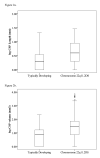Increased incidence and size of cavum septum pellucidum in children with chromosome 22q11.2 deletion syndrome
- PMID: 20074913
- PMCID: PMC2904971
- DOI: 10.1016/j.pscychresns.2009.10.009
Increased incidence and size of cavum septum pellucidum in children with chromosome 22q11.2 deletion syndrome
Abstract
Chromosome 22q11.2 deletion syndrome (22q11.2DS) is a result of a hemizygotic microdeletion that results in a variety of impairments in children including greater risk for psychiatric ailments in adulthood. We used high-resolution magnetic resonance imaging to accurately quantify the length and, for the first time, volume, of the cavum septum pellucidum (CSP) in children aged 7 to 14years with 22q11.2DS and typically developing (TD) controls. Significantly greater anteroposterior length and greater CSP volumes were found in children with 22q11.2DS compared with controls. Furthermore, the largest CSP were found only in the 22q11.2DS group and with a much higher incidence than previously reported in the literature. Given the significant midline anomalies in the brains of those affected by 22q11.2DS, large CSP may be a biomarker of atypical brain development. The implication of these larger CSP for cognitive and behavioral development is a topic in need of further investigation.
Copyright (c) 2009 Elsevier Ireland Ltd. All rights reserved.
Figures


Similar articles
-
Developmental trajectories of brain structure in adolescents with 22q11.2 deletion syndrome: a longitudinal study.Schizophr Res. 2007 Nov;96(1-3):72-81. doi: 10.1016/j.schres.2007.07.021. Epub 2007 Sep 4. Schizophr Res. 2007. PMID: 17804201 Free PMC article.
-
Identifying patterns of anxiety and depression in children with chromosome 22q11.2 deletion syndrome: comorbidity predicts behavioral difficulties and impaired functional communications.Behav Brain Res. 2015 Jan 1;276:190-8. doi: 10.1016/j.bbr.2014.05.056. Epub 2014 Jun 3. Behav Brain Res. 2015. PMID: 24906195 Free PMC article.
-
Enlarged cavum septum pellucidum and small thymus as markers for 22q11.2 deletion syndrome.Prenat Diagn. 2024 Jun;44(6-7):796-803. doi: 10.1002/pd.6555. Epub 2024 Mar 18. Prenat Diagn. 2024. PMID: 38497811
-
Cancer in 22q11.2 deletion syndrome: A case report and literature review.Eur J Med Genet. 2024 Aug;70:104959. doi: 10.1016/j.ejmg.2024.104959. Epub 2024 Jul 3. Eur J Med Genet. 2024. PMID: 38969060 Review.
-
[Neurocognitive and psychiatric management of the 22q11.2 deletion syndrome].Encephale. 2015 Jun;41(3):266-73. doi: 10.1016/j.encep.2014.10.005. Epub 2014 Dec 16. Encephale. 2015. PMID: 25523123 Review. French.
Cited by
-
Baseline connectome modular abnormalities in the childhood phase of a longitudinal study on individuals with chromosome 22q11.2 deletion syndrome.Hum Brain Mapp. 2018 Jan;39(1):232-248. doi: 10.1002/hbm.23838. Epub 2017 Oct 8. Hum Brain Mapp. 2018. PMID: 28990258 Free PMC article.
-
Comprehensive neurocognitive endophenotyping strategies for mouse models of genetic disorders.Prog Neurobiol. 2012 Feb;96(2):220-41. doi: 10.1016/j.pneurobio.2011.12.001. Epub 2012 Jan 13. Prog Neurobiol. 2012. PMID: 22266125 Free PMC article. Review.
-
Epilepsy in Muenke syndrome: FGFR3-related craniosynostosis.Pediatr Neurol. 2012 Nov;47(5):355-61. doi: 10.1016/j.pediatrneurol.2012.07.004. Pediatr Neurol. 2012. PMID: 23044018 Free PMC article. Review.
-
Long-term postnatal outcome of fetuses with prenatally suspected septo-optic dysplasia.Ultrasound Obstet Gynecol. 2020 Sep;56(3):371-377. doi: 10.1002/uog.22018. Ultrasound Obstet Gynecol. 2020. PMID: 32196785 Free PMC article.
-
Incidental radiologic findings in the 22q11.2 deletion syndrome.AJNR Am J Neuroradiol. 2014 Nov-Dec;35(11):2186-91. doi: 10.3174/ajnr.A4003. Epub 2014 Jun 19. AJNR Am J Neuroradiol. 2014. PMID: 24948496 Free PMC article.
References
-
- Antshel KM, Kates WR, Roizen N, Fremont W, Shprintzen RJ. 22q11.2 deletion syndrome: Genetics, neuroanatomy and cognitive/behavioral features. Neuropsychology, Development, and Cognition. Section C, Child Neuropsychology. 2005;11:5–19. - PubMed
-
- Bearden CE, Woodin MF, Wang PP, Moss E, McDonald-McGinn D, Zackai E, Emannuel B, Cannon TD. The neurocognitive phenotype of the 22q11.2 deletion syndrome: selective deficit in visual-spatial memory. Journal of Clinical and Experimental Neuropsychology. 2001;23:447–464. - PubMed
-
- Bish JP, Ferrante S, McDonald-McGinn D, Zackai E, Simon TJ. Maladaptive conflict monitoring as evidence for executive dysfunction in children with chromosome 22q11.2 deletion syndrome. Developmental Science. 2005;8:36–43. - PubMed
-
- Bish JP, Nguyen V, Ding L, Ferrante S, Simon TJ. Thalamic reductions in children with chromosome 22q11.2 deletion syndrome. Neuroreport. 2004;15:1413–1415. - PubMed
-
- Bodensteiner JB, Schaefer GB. Wide cavum septum pellucidum: a marker of disturbed brain development. Pediatric Neurology. 1990;6:391–394. - PubMed
Publication types
MeSH terms
Grants and funding
LinkOut - more resources
Full Text Sources

